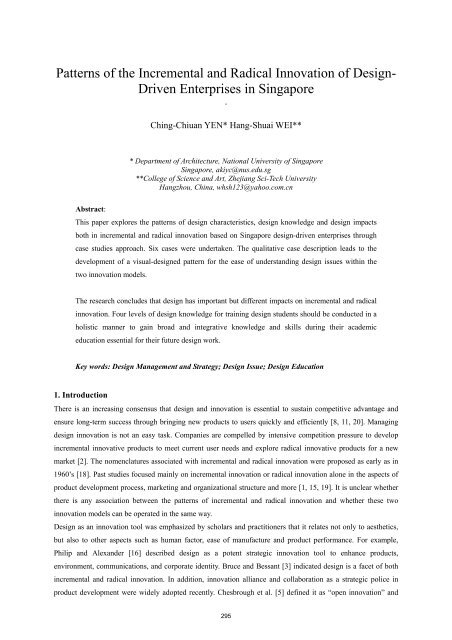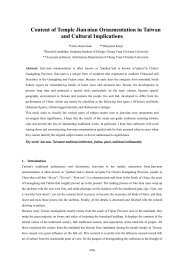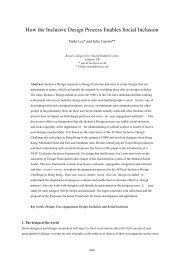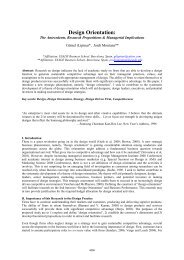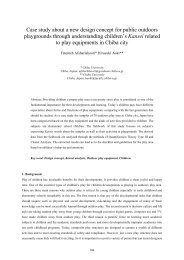Patterns of the Incremental and Radical Innovation of Design ...
Patterns of the Incremental and Radical Innovation of Design ...
Patterns of the Incremental and Radical Innovation of Design ...
You also want an ePaper? Increase the reach of your titles
YUMPU automatically turns print PDFs into web optimized ePapers that Google loves.
<strong>Patterns</strong> <strong>of</strong> <strong>the</strong> <strong>Incremental</strong> <strong>and</strong> <strong>Radical</strong> <strong>Innovation</strong> <strong>of</strong> <strong>Design</strong>-<br />
Driven Enterprises in Singapore<br />
.<br />
Ching-Chiuan YEN* Hang-Shuai WEI**<br />
* Department <strong>of</strong> Architecture, National University <strong>of</strong> Singapore<br />
Singapore, akiyc@nus.edu.sg<br />
**College <strong>of</strong> Science <strong>and</strong> Art, Zhejiang Sci-Tech University<br />
Hangzhou, China, whsh123@yahoo.com.cn<br />
Abstract:<br />
This paper explores <strong>the</strong> patterns <strong>of</strong> design characteristics, design knowledge <strong>and</strong> design impacts<br />
both in incremental <strong>and</strong> radical innovation based on Singapore design-driven enterprises through<br />
case studies approach. Six cases were undertaken. The qualitative case description leads to <strong>the</strong><br />
development <strong>of</strong> a visual-designed pattern for <strong>the</strong> ease <strong>of</strong> underst<strong>and</strong>ing design issues within <strong>the</strong><br />
two innovation models.<br />
The research concludes that design has important but different impacts on incremental <strong>and</strong> radical<br />
innovation. Four levels <strong>of</strong> design knowledge for training design students should be conducted in a<br />
holistic manner to gain broad <strong>and</strong> integrative knowledge <strong>and</strong> skills during <strong>the</strong>ir academic<br />
education essential for <strong>the</strong>ir future design work.<br />
Key words: <strong>Design</strong> Management <strong>and</strong> Strategy; <strong>Design</strong> Issue; <strong>Design</strong> Education<br />
1. Introduction<br />
There is an increasing consensus that design <strong>and</strong> innovation is essential to sustain competitive advantage <strong>and</strong><br />
ensure long-term success through bringing new products to users quickly <strong>and</strong> efficiently [8, 11, 20]. Managing<br />
design innovation is not an easy task. Companies are compelled by intensive competition pressure to develop<br />
incremental innovative products to meet current user needs <strong>and</strong> explore radical innovative products for a new<br />
market [2]. The nomenclatures associated with incremental <strong>and</strong> radical innovation were proposed as early as in<br />
1960’s [18]. Past studies focused mainly on incremental innovation or radical innovation alone in <strong>the</strong> aspects <strong>of</strong><br />
product development process, marketing <strong>and</strong> organizational structure <strong>and</strong> more [1, 15, 19]. It is unclear whe<strong>the</strong>r<br />
<strong>the</strong>re is any association between <strong>the</strong> patterns <strong>of</strong> incremental <strong>and</strong> radical innovation <strong>and</strong> whe<strong>the</strong>r <strong>the</strong>se two<br />
innovation models can be operated in <strong>the</strong> same way.<br />
<strong>Design</strong> as an innovation tool was emphasized by scholars <strong>and</strong> practitioners that it relates not only to aes<strong>the</strong>tics,<br />
but also to o<strong>the</strong>r aspects such as human factor, ease <strong>of</strong> manufacture <strong>and</strong> product performance. For example,<br />
Philip <strong>and</strong> Alex<strong>and</strong>er [16] described design as a potent strategic innovation tool to enhance products,<br />
environment, communications, <strong>and</strong> corporate identity. Bruce <strong>and</strong> Bessant [3] indicated design is a facet <strong>of</strong> both<br />
incremental <strong>and</strong> radical innovation. In addition, innovation alliance <strong>and</strong> collaboration as a strategic police in<br />
product development were widely adopted recently. Chesbrough et al. [5] defined it as “open innovation” <strong>and</strong><br />
295
suggested firms could <strong>and</strong> should use internal ideas as well as external ideas. Many o<strong>the</strong>r scholars also agreed<br />
that alliances, outsource <strong>and</strong> partnerships with o<strong>the</strong>r companies, institutions <strong>and</strong> universities are <strong>the</strong> essential<br />
sources in <strong>the</strong> innovation process [7, 9, 17]. It is essential to determine three important but unclear issues:<br />
innovation process <strong>and</strong> its outcome, design involvement & impacts <strong>and</strong> collaboration in <strong>the</strong> incremental <strong>and</strong><br />
radical innovation, for in-depth underst<strong>and</strong>ing on how to manage <strong>the</strong>se two innovation models effectively <strong>and</strong><br />
successfully, which will be a good contribution for today’s product innovation <strong>the</strong>ory framework.<br />
2. Research methodology<br />
2.1 Research Process<br />
This research focuses on a comparative study <strong>of</strong> <strong>the</strong> incremental <strong>and</strong> radical innovation in order to gain an<br />
underst<strong>and</strong>ing <strong>of</strong> patterns between both innovation models adopted by <strong>the</strong> Singapore design-driven companies.<br />
The research is not only to evaluate <strong>the</strong> existing <strong>the</strong>ories in practice but also to explore <strong>and</strong> investigate <strong>the</strong><br />
contemporary phenomenon <strong>of</strong> design <strong>and</strong> innovation in practices, in order to inform such <strong>the</strong>ories. Thus, using<br />
case study method would be <strong>the</strong> most appropriate research method to ga<strong>the</strong>r contextual underst<strong>and</strong>ing about<br />
design <strong>and</strong> innovation patterns. An overview <strong>of</strong> research process is shown in Figure 1.<br />
Figure.1 Research process <strong>of</strong> this study<br />
2.2 Selection <strong>of</strong> cases<br />
This study aims to get <strong>the</strong> representative information <strong>of</strong> product design <strong>and</strong> innovation patterns through<br />
investigating appropriate design-driven companies within Singapore. Based on Langrish’s [14] case study<br />
selection, <strong>the</strong> “representative” “<strong>the</strong> one next door” <strong>and</strong> “<strong>the</strong> best practice” approaches were adopted to this study.<br />
The principles about selection <strong>of</strong> companies are:<br />
� The representative: Firms that have good performance in product design <strong>and</strong> innovation in Singapore.<br />
296
� The one next door: Firms where investigators have easy access to <strong>the</strong> design managers or NPD managers for<br />
interview.<br />
� The best practice: <strong>the</strong> competition winner or award winning companies.<br />
Considering <strong>the</strong> principles mentioned above, this study focuses on <strong>the</strong> electronic manufacturing industry such as<br />
consumer electronics, telecommunication, domestic appliances, health <strong>and</strong> lifestyle, which requires excellent<br />
design <strong>and</strong> innovation performance. Six firms were selected for case studies with <strong>the</strong> agreement <strong>of</strong> participation.<br />
3. Analysis <strong>and</strong> Discussion <strong>of</strong> <strong>the</strong> Research Findings<br />
3.1 <strong>Innovation</strong> impact in business performance<br />
Table 1 presents six companies’ views about <strong>the</strong> objectives <strong>of</strong> incremental <strong>and</strong> radical innovation related to <strong>the</strong>ir<br />
business performance.<br />
Table 1 Comparison about <strong>the</strong> objectives <strong>of</strong> incremental <strong>and</strong> radical innovation in six cases<br />
<strong>Incremental</strong> innovation <strong>Radical</strong> innovation<br />
COM1 Good sale<br />
Create new market industry<br />
High pr<strong>of</strong>it<br />
Boost company image <strong>and</strong> br<strong>and</strong> value<br />
To gain new revenue<br />
COM2 Reduce <strong>the</strong> cost <strong>of</strong> production Become market leader<br />
Roll out faster to get market share Explore new market potential<br />
Maintain <strong>the</strong> top br<strong>and</strong> image<br />
COM3 Quick turn around<br />
Explore new direction for <strong>the</strong> product house<br />
Gain margin<br />
Build <strong>the</strong> br<strong>and</strong> image<br />
Make money, but not necessary<br />
COM4 Maintain <strong>the</strong> pr<strong>of</strong>it<br />
Position Br<strong>and</strong> image<br />
Keep <strong>the</strong> market share<br />
Explore new potential market<br />
Push <strong>the</strong> frontiers<br />
COM5 Follow up customer requests On-going research <strong>and</strong> exploration to push boundaries for<br />
Gain <strong>the</strong> market share<br />
better innovation<br />
safe revenue<br />
Show <strong>the</strong> company is forward-thinking<br />
COM6 Keep <strong>the</strong> product’s competitiveness Explore potential market<br />
Obtain revenue<br />
Gain incomings<br />
Sets up positive br<strong>and</strong> image<br />
As indicated in <strong>the</strong> Table 1, incremental <strong>and</strong> radical innovations have different but complementary impacts on<br />
business performance as follows:<br />
<strong>Incremental</strong> innovation: is <strong>the</strong> main force to maintain <strong>the</strong> pr<strong>of</strong>it <strong>and</strong> maintain <strong>the</strong> market share. All <strong>the</strong> six<br />
companies indicated that incremental innovation is to provide better sale <strong>and</strong> obtain more revenue. The<br />
improvement <strong>and</strong> upgrading <strong>of</strong> product are based on customer’s requests or even to reduce costs to keep <strong>the</strong><br />
product’s competency. High intensive competitions impel <strong>the</strong>m to focus on incremental innovation to survive.<br />
Thus, <strong>the</strong> successful implementation <strong>of</strong> incremental innovation will be one <strong>of</strong> <strong>the</strong> key factors contributing to <strong>the</strong><br />
success <strong>of</strong> <strong>the</strong> company.<br />
<strong>Radical</strong> innovation: has three impacts to business as follows:<br />
1. Push boundaries to create new potential market <strong>and</strong> detect market reactions: All <strong>the</strong> six companies agreed<br />
that radical innovation can create new market directions. It is a powerful tool to make <strong>the</strong> company become<br />
297
market leader, as companies can push <strong>the</strong> current product boundaries into new areas for new business<br />
growth. <strong>Radical</strong> innovation meets this dem<strong>and</strong> through <strong>the</strong> exploration <strong>of</strong> potential customer needs or<br />
identification <strong>of</strong> potential market. However, due to high cost <strong>and</strong> high market uncertainty, most radical<br />
innovations were not “top sale”, some even fail, which indicated <strong>the</strong> development <strong>of</strong> radical innovation is a<br />
risk task. That is why <strong>the</strong> number <strong>of</strong> radical innovation is far fewer than that <strong>of</strong> incremental innovation in<br />
most companies. Most <strong>of</strong> <strong>the</strong> time, radical innovation plays <strong>the</strong> pilot role to detect market expectations.<br />
After <strong>the</strong> launch, feedback from market (customers or users) can provide more appropriate directions for<br />
forthcoming next generation products, to gain a better market position. These approaches have been widely<br />
adopted in <strong>the</strong> strategy <strong>of</strong> car industry which produces concept car in <strong>the</strong> exhibition to show <strong>and</strong> test market<br />
reactions <strong>and</strong> feedbacks. [13]<br />
2. Boost company image <strong>and</strong> add br<strong>and</strong> value: All <strong>the</strong> respondents indicated radical innovation can have<br />
significant impact on <strong>the</strong> br<strong>and</strong> value <strong>and</strong> company image. In general, radical innovation can positively<br />
deliver <strong>the</strong> message that <strong>the</strong> company is forward thinking when <strong>the</strong> customers see <strong>the</strong> innovations in <strong>the</strong><br />
advertisement or try <strong>the</strong>m on <strong>the</strong> market, etc. <strong>Radical</strong> innovations can also attract more investments from<br />
stakeholders or o<strong>the</strong>r sources. Even though <strong>the</strong> sale <strong>of</strong> radical innovation may not be a success, <strong>the</strong> br<strong>and</strong><br />
value is still streng<strong>the</strong>ned due to <strong>the</strong> positive <strong>and</strong> forward thinking image portrayed by <strong>the</strong> company. Thus,<br />
most well-known br<strong>and</strong> companies launched a few radical products every year to keep customers interested<br />
<strong>and</strong> demonstrate <strong>the</strong> latest excellent research achievements to <strong>the</strong> public <strong>and</strong> competitors.<br />
3. To gain revenue: Almost half <strong>of</strong> <strong>the</strong> respondents indicated that gaining revenue is also one <strong>of</strong> <strong>the</strong> main<br />
objectives <strong>of</strong> radical innovation. As <strong>the</strong> newly launched radical innovative product may attract more<br />
customers to buy <strong>the</strong> product, generally, <strong>the</strong> price <strong>of</strong> radical products is much higher than incremental<br />
products. However, as most respondents indicated, <strong>the</strong> revenue gained by radical innovation is limited. The<br />
potential is <strong>the</strong> creation <strong>of</strong> new market for better incomings.<br />
3.2 Product design characteristics<br />
Figure 2 <strong>and</strong> Figure 3 demonstrate that <strong>the</strong> characteristics <strong>of</strong> incremental <strong>and</strong> radical innovation in each company<br />
vary due to <strong>the</strong> different market requirement <strong>and</strong> business strategy, etc.<br />
Figure 2 Comparison <strong>of</strong> product characteristics between incremental <strong>and</strong> radical innovation<br />
298
Figure 3 Market information <strong>of</strong> incremental <strong>and</strong> radical products<br />
From Figure 2 <strong>and</strong> Figure 3, it can be found that differences in <strong>the</strong> product characteristics existed in incremental<br />
<strong>and</strong> radical innovation as follows:<br />
� <strong>Incremental</strong> innovation: redesign <strong>and</strong> upgrading technology -oriented<br />
<strong>Incremental</strong> innovation needs to consider cost, development schedule <strong>and</strong> market risk. As discussed<br />
previously, <strong>the</strong>se products mainly focus on redesigning <strong>the</strong> product form <strong>and</strong> applying <strong>the</strong> upgraded<br />
technologies to improve <strong>the</strong>ir functions. In some cases, incremental innovation also involves new<br />
technologies or new materials; however, <strong>the</strong>re is a big difference in <strong>the</strong> purpose <strong>of</strong> adopting new<br />
technologies between incremental <strong>and</strong> radical innovation. In incremental innovation, new technologies <strong>and</strong><br />
materials were used to assist improvement <strong>of</strong> existing product system, while radical innovation adopts new<br />
technologies or new materials as <strong>the</strong> innovation drive to develop extremely new products.<br />
� <strong>Radical</strong> innovation: design & creativity <strong>and</strong> new technology -oriented<br />
Comparing to incremental innovation, radical innovation is far beyond <strong>the</strong> current products. As discussed<br />
above, <strong>the</strong>re are two kinds <strong>of</strong> orientation in <strong>the</strong> radical innovation. One is new application <strong>of</strong> current<br />
technologies or materials to innovation. This type <strong>of</strong> radical innovation is design <strong>and</strong> creativity orientation,<br />
which requires <strong>the</strong> development team with open-minded thinking to identify potential opportunities. The<br />
o<strong>the</strong>r is new technology orientation. This type <strong>of</strong> radical innovations involves <strong>the</strong> application <strong>of</strong> new<br />
developed technologies. The role <strong>of</strong> design is only to support <strong>the</strong> transformation <strong>of</strong> technologies into a real<br />
product.<br />
3.3 Product innovation process<br />
The case studies indicate innovation process <strong>and</strong> activities in each company consist <strong>of</strong> five main phases: research<br />
& assessment, concept generation, evaluation, production <strong>and</strong> launch, which is called “five steps” process in this<br />
article (See Figure 4). The “five-step” process is similar to that <strong>of</strong> new product development process suggested<br />
by Crawford [6] but with an integration research process as a start point <strong>of</strong> innovation.<br />
Figure 4 “Five steps” innovation process based on six case studies<br />
299
However, According to <strong>the</strong> research finding, innovation activities in each phase vary from one company to<br />
ano<strong>the</strong>r, which depend on company’s execution preference <strong>and</strong> project situation. For most companies, radical<br />
innovation shares <strong>the</strong> same process with incremental innovation, but <strong>the</strong> contents <strong>of</strong> activities <strong>and</strong> emphasis are<br />
different; <strong>the</strong> sequence <strong>of</strong> sub-steps in radical innovation is fuzzy, especially in <strong>the</strong> initial phase.<br />
3.4 Levels <strong>of</strong> design knowledge in <strong>the</strong> product innovation<br />
Table 2 <strong>and</strong> Table 3 demonstrates, within both incremental <strong>and</strong> radical innovation, design plays an important role<br />
<strong>and</strong> has various impacts on all <strong>the</strong> phases. Various design activities required a lot <strong>of</strong> knowledge to execute design<br />
tasks, which can be categorised into four levels: basic operations & skills, tacit knowledge, design strategic<br />
knowledge <strong>and</strong> visionary capabilities. Based on Hytőnen et al’s [10] model, a new level <strong>of</strong> capability has been<br />
added, i.e. visionary capability.<br />
Table 2 Six companies’ design impacts in incremental <strong>and</strong> radical innovation<br />
<strong>Design</strong> impact in incremental innovation <strong>Design</strong> impact in radical innovation<br />
COM1 Concept generation<br />
Concept generation<br />
Styling<br />
Styling<br />
Usability<br />
UI<br />
<strong>Design</strong> coordinating<br />
Coordination<br />
COM2 Product styling design<br />
Product styling design<br />
Prototype<br />
Prototype<br />
User research<br />
More in-depth user research<br />
Project presentation<br />
Presentation<br />
Coordination with o<strong>the</strong>r people<br />
High involvement <strong>of</strong> coordination<br />
COM3 Research<br />
Research<br />
Usability<br />
Usability<br />
UI<br />
User experience<br />
Packaging<br />
<strong>Design</strong> execution<br />
COM4 Concept generation<br />
Concept generation<br />
Visualization<br />
Visualization<br />
<strong>Design</strong> execution<br />
<strong>Design</strong> execution<br />
COM5 Plan <strong>the</strong> product portfolio <strong>of</strong> <strong>the</strong> company<br />
Identify potential areas in <strong>the</strong> research stage<br />
Explore <strong>the</strong> potential customer needs<br />
COM6 Research about <strong>the</strong> form establishment Research about <strong>the</strong> form establishment<br />
PI (product identity) design<br />
PI (product identity) design<br />
Prototype<br />
Prototype<br />
Gate keeper in <strong>the</strong> production phase Gate keeper in <strong>the</strong> production phase<br />
Basic operations & skills: <strong>the</strong>se are <strong>the</strong> basic requirements for design execution. The main operations <strong>and</strong> skills<br />
identified in <strong>the</strong> case studies are product styling, aes<strong>the</strong>tics, prototyping, sketching, usability <strong>and</strong> user research;<br />
sometimes UI (user interface) <strong>and</strong> packaging also need designers to accomplish. Besides, a lot <strong>of</strong> o<strong>the</strong>r design<br />
related knowledge, such as modelling technologies, material finishing, mechanical design, supply chain,<br />
business <strong>and</strong> market knowledge is required to be understood by designers.<br />
Tacit knowledge: this study also discovered tacit knowledge related to personal features such as coordination<br />
capabilities, design presentation skills <strong>and</strong> negotiation abilities is important in <strong>the</strong> innovation process. Many<br />
subjects mentioned that coordination is an essential design impact. <strong>Design</strong> or innovation requires this tacit<br />
knowledge for better <strong>and</strong> smoo<strong>the</strong>r execution.<br />
300
<strong>Design</strong> strategic knowledge: many responses indicated that design strategy, product position <strong>and</strong> br<strong>and</strong>ing are<br />
very essential in <strong>the</strong> product innovation. These design strategic knowledge focuses much more on product<br />
portfolios <strong>and</strong> br<strong>and</strong>ed house [12]. It belongs to <strong>the</strong> strategic management level. This research finding illustrates<br />
that design is recognized in some companies to optimize <strong>the</strong> product position <strong>and</strong> br<strong>and</strong> image. For instance,<br />
COM3 used design strategy to set up <strong>the</strong> right product position. COM6 adopted design language to build up <strong>the</strong><br />
product identity to deliver consistent br<strong>and</strong> image to public. As a strategic role, designers are required to have<br />
high level <strong>of</strong> knowledge in business, marketing, finance <strong>and</strong> design management. In this way, designers can have<br />
a shared language with business managers for better underst<strong>and</strong>ing <strong>of</strong> product strategy, which is helpful for<br />
design execution.<br />
Visionary capabilities: most interviewees indicated designers should be creative, forward thinking <strong>and</strong> predict<br />
what is <strong>the</strong> new user scenario for <strong>the</strong> new design, which is coined as visionary capabilities. Visionary capability<br />
is beyond <strong>the</strong> product style design, which focuses more on finding new solutions, new user experiences or<br />
approaches for future products. It considers what <strong>the</strong> products are supposed to be without being restricted by <strong>the</strong><br />
current product systems. All <strong>the</strong> companies indicated designers should have such creative abilities to explore <strong>the</strong><br />
potential customer needs <strong>and</strong> develop revolutionary new product for <strong>the</strong> future. Therefore, design plays a very<br />
important role in product innovation, especially for radical innovation. It requires designers with a systematic<br />
knowledge for visionary capability: high ability <strong>of</strong> observation, in-depth insight <strong>of</strong> product usage scenario, broad<br />
research ability, <strong>and</strong> creative-thinking genius.<br />
Table 3 <strong>Design</strong> knowledge requirements in incremental <strong>and</strong> radical innovation within six companies<br />
<strong>Design</strong> requirement in incremental innovation <strong>Design</strong> requirement in radical innovation<br />
COM1 Basic knowledge such as:<br />
Creativity<br />
Modelling technologies<br />
Coordination to support <strong>the</strong> whole process<br />
Material finishing,<br />
High ability <strong>of</strong> observation<br />
Mechanical structure<br />
In-depth insight <strong>of</strong> product usability<br />
Research ability<br />
COM2 High ability <strong>of</strong> aes<strong>the</strong>tic design<br />
Exploring <strong>and</strong> determining <strong>the</strong> potential use<br />
Ability to solve occurred usability problems problems or requirements<br />
Creativity <strong>and</strong> looking forward thinking<br />
COM3 Ability <strong>of</strong> detail design Product position<br />
<strong>Design</strong> strategy<br />
COM4 <strong>Design</strong> skills<br />
Business <strong>and</strong> marketing knowledge<br />
High ability <strong>of</strong> Coordination<br />
COM5 Styling <strong>and</strong> aes<strong>the</strong>tics<br />
High abilities to solve customer requirements<br />
High abilities to foresee <strong>the</strong> futures <strong>of</strong> products<br />
COM6 Consistency <strong>of</strong> design language Usage scenario <strong>and</strong> product creativity<br />
As discussed above, Figure 5 presents <strong>the</strong>se four levels <strong>of</strong> design knowledge for better underst<strong>and</strong>ing.<br />
For incremental innovation, design plays more on product form <strong>and</strong> function, <strong>and</strong> covers activities such as<br />
concept generation, product aes<strong>the</strong>tic, usability, prototyping, presentation, coordination, product portfolio <strong>and</strong><br />
strategy planning, which implies incremental innovation requires design knowledge in 1) basic operation &<br />
skills, 2) tacit knowledge <strong>and</strong> 3) design strategic knowledge. For radical innovation, design covers activities such<br />
as creativities, basic research, product styling, usability, prototype, presentation <strong>and</strong> coordination, which<br />
301
suggested that design in radical innovation focuses on 1) basic operation & skills, 2) tacit knowledge <strong>and</strong> 3)<br />
visionary capabilities. Figure 6 presents <strong>the</strong> design knowledge allocation in incremental <strong>and</strong> radical innovation<br />
which indicates that basic operation & skills <strong>and</strong> tacit knowledge are required by both incremental <strong>and</strong> radical<br />
innovation. However, visionary capability is <strong>the</strong> most important for radical innovation, while basic design<br />
knowledge <strong>and</strong> skills are <strong>the</strong> essence for incremental innovation.<br />
.<br />
Figure 5 Classification <strong>of</strong> design knowledge<br />
Figure 6 Allocation <strong>of</strong> design knowledge in incremental <strong>and</strong> radical innovation<br />
5. Conclusions<br />
The research findings demonstrated that:<br />
� <strong>Incremental</strong> <strong>and</strong> radical innovations have different objectives in business strategic directions. <strong>Incremental</strong><br />
innovation is for pr<strong>of</strong>it <strong>and</strong> revenue while radical innovation is to explore new market potential <strong>and</strong> boost<br />
br<strong>and</strong> image.<br />
� Products resulting from incremental <strong>and</strong> radical innovation possess different design characteristics.<br />
<strong>Incremental</strong> innovation involves redesign <strong>and</strong> upgrading that is always technology-oriented, while radical<br />
innovation could ei<strong>the</strong>r be design & creativity-oriented or new technology –oriented.<br />
302
� Most <strong>of</strong> <strong>the</strong> companies share a similar process with incremental <strong>and</strong> radical innovation, but <strong>the</strong> contents <strong>and</strong><br />
emphasis are different. <strong>Radical</strong> innovation focuses on research phase (fuzzy front end) with a more iterative<br />
<strong>and</strong> concurrent process than that <strong>of</strong> incremental innovation.<br />
� <strong>Design</strong>ers are required to possess four levels <strong>of</strong> knowledge: basic operations & skills, tacit knowledge,<br />
design strategic knowledge, <strong>and</strong> visionary capabilities. <strong>Incremental</strong> innovation <strong>and</strong> radical innovation<br />
requires different design knowledge, which indicates incremental innovation more emphasizes on basic<br />
operation & skills, while radical innovation more focuses on visionary capabilities.<br />
The research finding suggests several tentative guidelines for design <strong>and</strong> innovation. First, though radical<br />
innovation incurs high cost <strong>and</strong> is risky to explore, companies, especially for those seeking to set up br<strong>and</strong> image,<br />
cannot ignore but instead, should recognize its key effects on creation <strong>of</strong> new market <strong>and</strong> enhancement <strong>of</strong> br<strong>and</strong><br />
image, which cannot be achieved by incremental innovation. Second, design is essential to play in accelerating<br />
<strong>the</strong> innovation pace through leading <strong>and</strong> supporting <strong>the</strong> whole process from business strategy decision to<br />
manufacturing <strong>and</strong> launch. Companies should utilize <strong>the</strong> design for better innovation. Third, innovation requiring<br />
four levels <strong>of</strong> design knowledge evokes <strong>the</strong> appropriate design recruitment <strong>and</strong> training. This research finding<br />
suggests that design education should review <strong>the</strong> design training to move away from traditional view <strong>of</strong> design<br />
as aes<strong>the</strong>tics & styling towards a new perception <strong>of</strong> design in systematic curriculum including creativity, strategy<br />
<strong>and</strong> management. <strong>Design</strong>ers should be trained in a holistic approach <strong>and</strong> broader based design programs which<br />
cover a multi-disciplinary approach, such as <strong>the</strong> involvement <strong>of</strong> business management, marketing, engineering<br />
etc.<br />
6. References<br />
[1] Bessant, J., Caffyn, S., Gilbert, J., Harding, R. <strong>and</strong> Webb, S., (1994). Rediscovering continuous improvement.<br />
Technovation, vol. 14, no. 1, pp.17-29.<br />
[2] Boer, H. <strong>and</strong> Gertsen, F., (2003). From continuous improvement to continuous innovation: A retro respective.<br />
International Journal <strong>of</strong> Technology Management, vol. 26, no. 8, pp.:805-827.<br />
[3] Bruce, M. <strong>and</strong> Bessant, J., (2002). <strong>Design</strong> in business: strategic innovation through design. London:<br />
Financial Times/Prentice Hall.<br />
[4] Bruce, M. <strong>and</strong> Harun, R., (2001), Exploring design capability for serial innovation in SMEs desire, 4th<br />
European Academy <strong>of</strong> <strong>Design</strong> Conference, Aveiro, 10 – 12 April 2001, pp.260-263.<br />
[5] Chesbrough, H., Vanhaverbeke, W. <strong>and</strong> West, J. (eds.) (2006). Open <strong>Innovation</strong>: Researching: A New<br />
Paradigm, Oxford University Press, Oxford.<br />
[6] Crawford, C, M., 1997. New products management. 5th edition, Chicago: Irwin.<br />
[7] Freeman. C., (1991). Networks <strong>of</strong> innovators: a syn<strong>the</strong>sis <strong>of</strong> research issues. Research Policy, vol. 20, no. 5,<br />
pp. 499-514.<br />
303
[8] Gemser, G. <strong>and</strong> Leenders,M,A,A,M., (2000). How integrating industrial design in <strong>the</strong> product development<br />
process impacts on company performance. Journal <strong>of</strong> Product <strong>Innovation</strong> Management, vol. 18, no. 1, pp 28-38.<br />
[9] Huston, L. <strong>and</strong> Sakkab, N., (2006). Connect <strong>and</strong> Develop: Inside Procter & Gamble’s New Model for<br />
<strong>Innovation</strong>. Harvard business school publishing, Boston.<br />
[10] Hytönen, J., Järvinen, J. <strong>and</strong> Tuulenmäki, A., (2004). From design services to strategic consulting:<br />
improving core competence <strong>of</strong> Finnish design consultancies. Helsinki: <strong>Design</strong>ium.<br />
[11] Kaplan, R.S., (2003). Managing <strong>Innovation</strong>. Harvard business school publishing, Boston.<br />
[12] Kapferer, Jean-Noël., (2004). The new strategic br<strong>and</strong> management: creating <strong>and</strong> sustaining br<strong>and</strong> equity<br />
long term. London : Kogan Page.<br />
[13] Keinonen, T. <strong>and</strong> Takala, R., (2005). Product concept design: A review <strong>of</strong> <strong>the</strong> conceptual design <strong>of</strong> products<br />
in industry. New York: Springer.<br />
[14] Langrish, J., (1993). Case studies as a biological research process. <strong>Design</strong> Studies, vol. 14, no. 4, pp. 357-<br />
364.<br />
[15] O’Connor, G, C., (1998). Marketing Learning <strong>and</strong> <strong>Radical</strong> <strong>Innovation</strong>: A cross Case Comparison <strong>of</strong> eight<br />
radical innovation projects. Journal <strong>of</strong> Product <strong>Innovation</strong> Management, vol. 15, no.2, pp.151-166.<br />
[16] Philip, K. <strong>and</strong> Alex<strong>and</strong>er, R, G., (1984). <strong>Design</strong>: a powerful but neglected strategic tool. Journal <strong>of</strong> Business<br />
Strategy, vol. 5, no. 2, pp.16-22.<br />
[17] Quinn, J.B., (2000). Outsourcing innovation: <strong>the</strong> new engine <strong>of</strong> growth. Sloan Management Review, vol. 41,<br />
no. 4, pp.13-28.<br />
[18] Robertson, T, S., (1967). The process <strong>of</strong> innovation <strong>and</strong> <strong>the</strong> diffusion <strong>of</strong> innovation. Journal <strong>of</strong> Marketing,<br />
31(1):14-19.<br />
[19] Veryzer, R, W., (2005). The roles <strong>of</strong> marketing <strong>and</strong> industrial design in discontinuous new product<br />
development. Journal <strong>of</strong> Product <strong>Innovation</strong> Management, vol. 22, no. 1, pp.22-41.<br />
[20] Von Stamm, B., (2003). Managing <strong>Innovation</strong>, <strong>Design</strong>, Creativity. J. Wiley, New York.<br />
304


